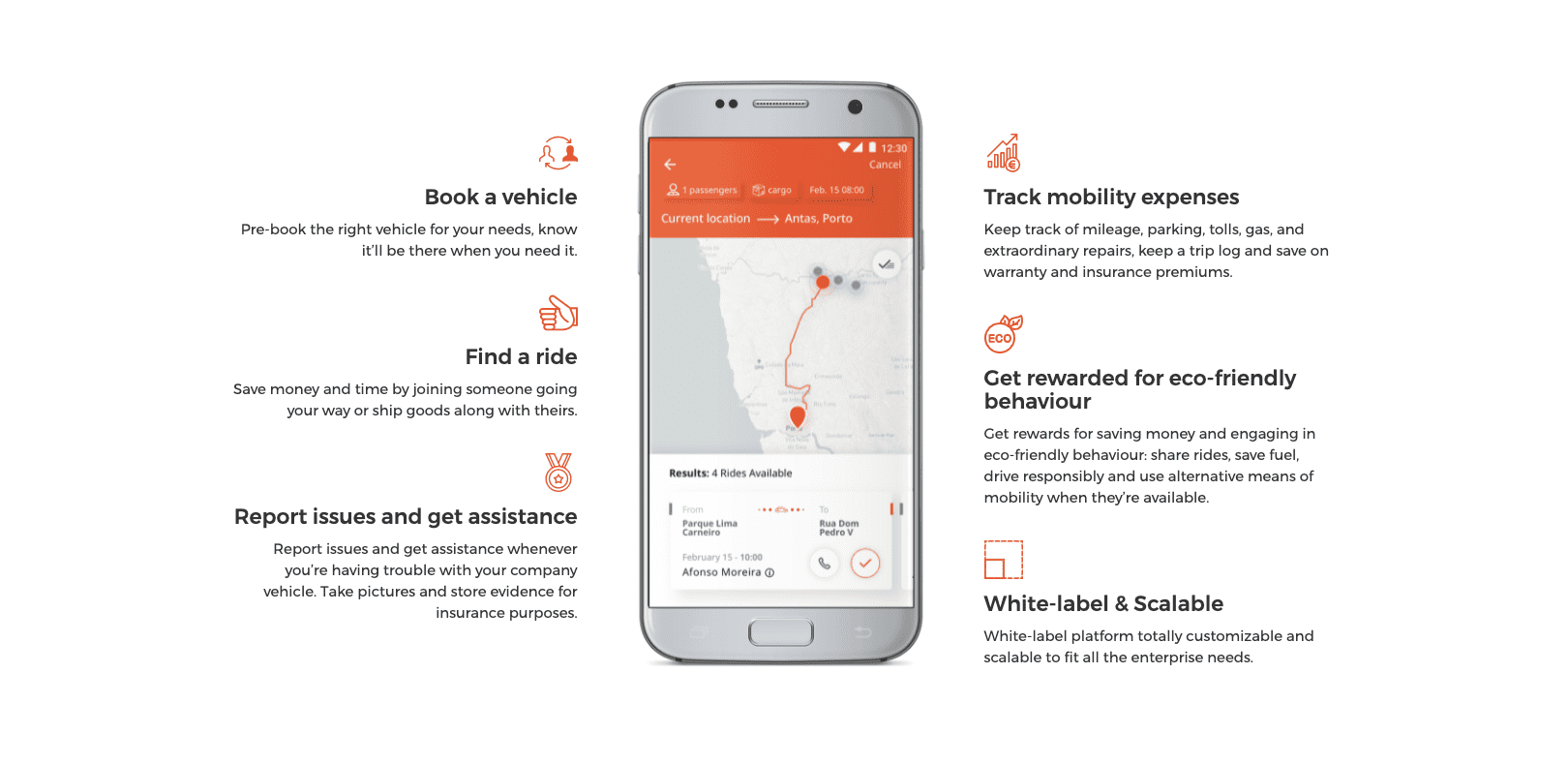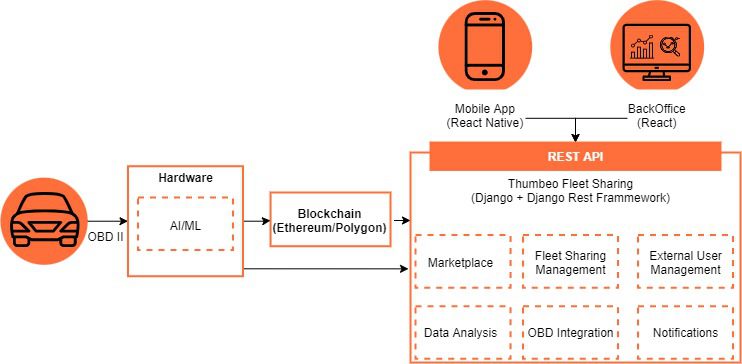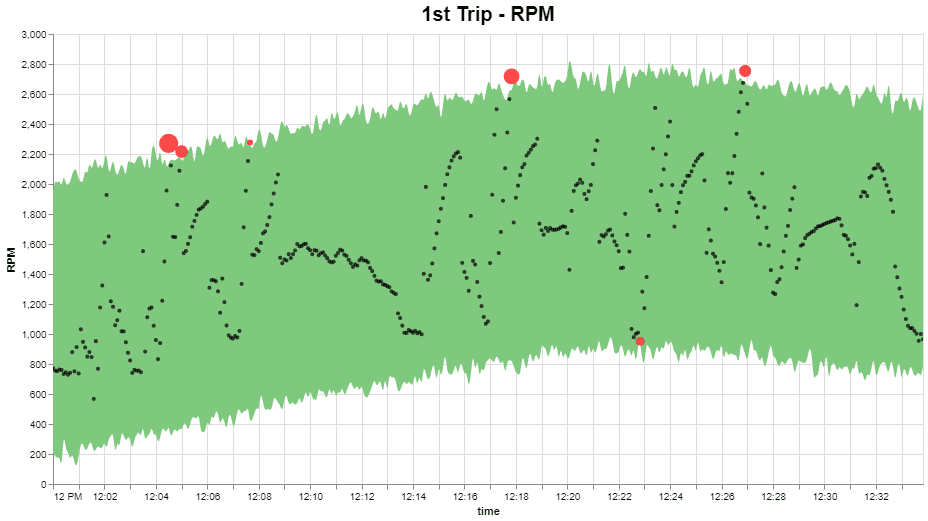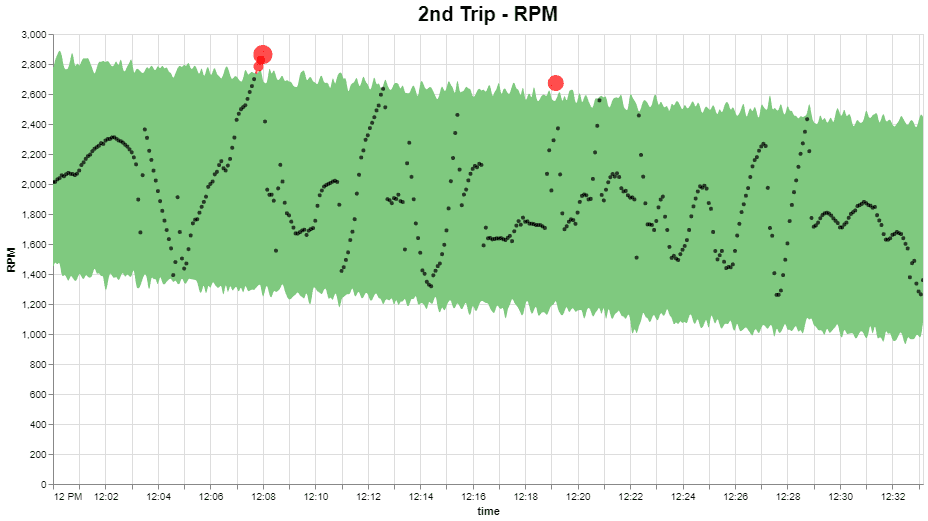Challenge & Context
In an era in which the concept of a shared economy has gained increasing relevance, there now are many companies possessing large fleets of vehicles going unused a lot of the time with no operating profits.
The lack of a holistic view of the real mobility needs of one’s employees is a huge challenge for those who manage a fleet with hundreds of vehicles.
To tackle this issue, along with PROEF, Ubiwhere has been improving and validating a technological solution called Thumbeo Corporate, which digitizes fleet management and permits sharing of vehicles among employees, whether for transportation of goods or passengers.
Ubiwhere has been engaged to enrich the Thumbeo Corporate solution with an innovative fleet sharing functionality. It is now working on a vehicle marketplace with companies with the objective to expand their business, without the high risk and investment of acquiring or renting vehicles in the long term.
This new solution includes the most appropriate technologies to ensure transparency among the various stakeholders involved, from Smart Contracts to Blockchain-based decentralized networks. Additionally, various artificial intelligence algorithms will allow not only the creation of Digital Twins of vehicles, but also the intelligent analysis of travel patterns and driving behaviours based on data collected from vehicle components. This will help ensure a good condition of the vehicles, enable predictive maintenance and reduce operating costs. This will also assist fleet managers with maintenance decisions and ensure their confidence in who rents their vehicles.
It is expected that this innovative fleet sharing solution will make managing fleets more efficient and, by reducing the number of vehicles on the road, also contribute to the reduction of CO2 emissions.
FIWARE, through their components, open standards and data models, allowed Ubiwhere already in the past to build scalable solutions, capable of integrating data from various sources easily, able to manage the involved IoT devices and provide the information to stakeholders in real-time. Also in the case of Thumbeo, these elements play a significant role.
Solution
The Fleet Sharing @Thumbeo Corporate project aims to create innovation in the business field using digital twins and artificial intelligence, among other emerging technologies.
In this project, Ubiwhere enriches its previously implemented Thumbeo Corporate solution with a fleet sharing feature and leverages the creation of a marketplace for car-sharing between distinct companies. This marketplace will enable companies intending to expand their business to acquire vehicles on-demand without the high risk and investment of purchase or long-term leasing. At the same time, this marketplace will enable companies with large fleets to utilize unused vehicles in periods of lower productivity.
Figure 1 . Mobile App
The project uses technologies that guarantee transparency between the various stakeholders involved, a stage in which digital twins and artificial intelligence algorithms play a fundamental role. The artificial intelligence (AI) algorithms that are currently being developed based on machine learning techniques, will enable not only the creation of the vehicle’s digital twin (in combination with OBD-II/EOBD devices for data collection) but also demonstrate travel patterns and driving behaviour, as well as permit the analysis of data collected from vehicle components, for the purpose of predictive maintenance and cost reduction.
Digital twins can turn a physical product reprogrammable. In addition, digital twins can be reprogrammed automatically. Through the introduction of sensors in the physical product, artificial intelligence technologies and predictive analysis, this reprogrammable nature leads to new functionalities.
In the automotive industry, if the sensor is combined with an artificial intelligence system, namely machine learning techniques, it is possible to replace the conventional maintenance model based on distance and time travelled, with a model in which it is the digital twin of the vehicle that defines the best moment for maintenance. This moment is calculated based on an analysis of the evolution of the vehicle’s performance and the cost of each necessary procedure, calculating the optimal moment to minimize costs.
In this case, artificial intelligence would allow, for example, to send a message to the user with the information that if certain maintenance was carried out at that moment, with a cost of ‘x’, corresponding to an increase in vehicle performance of ‘y’, that cost would be paid in a time period of ‘z’.
Another specific example of combining digital twins with machine learning techniques in the automotive industry is the possibility for the company to analyze and classify the driving performed in a given vehicle. This allows the company to suggest the incorporation of new components in the vehicle that can, for example, reduce road accidents or reduce maintenance costs, in a short period of time.
FIWARE enables this solution at various stages of the system. FIWARE’s IoT Agent makes it easier to manage the communication between the device and the central server through well known protocols such as HTTP and MQTT.
Additionally, Orion Context Broker is used both to consume the data provided by the various IoT devices, as well as to distribute data in real-time to the other components, making it possible for fleet managers to monitor their fleet of vehicles in real-time.
Finally, FIWARE’s Smart Data Models are used to represent various objects of the system, such as devices and vehicles, as well as important external data such as traffic and parking data.
How it works
In the diagram shown in Fig 2., it is possible to observe the general architecture of the system.
Figure 2 . Solution Architecture
A hardware device based on RaspberryPi has been developed in order to connect to the OBD port of the vehicle and extract the data from it. From there, some AI methods are applied directly on the device, distributing the processing. Finally, the device communicates the data through an LTE connection both to the blockchain and to the cloud server. Blockchain-based event processing covers events such as engine problems, so that it is possible for everyone to see issues that could appear in the vehicle during renting. General data is sent to the server, where it can be stored, monitored, analysed and displayed for the fleet managers. This communication is processed through FIWARE’s IoT Agent, which connects to the existing Context Broker in order to feed data from the vehicles in real-time.
Through a back-office application, fleet managers can interact with the data and services in the cloud to manage their fleet. The communication between the server and the application can be done through a REST API (Representational State Transfer), or through Orion Context Broker in the cases where we want to get it in real-time. External users can utilize an Android application where they can search for and request the renting of available vehicles.
When possible and relevant, data is stored and shared using the format of FIWARE’s Smart Data Models, making it easier to both consume, share and work with the data.
In Fig 3., it is possible to see some AI techniques being applied to the supplied data. In this case, time series forecasting methods are being used to understand where expected values for certain metrics will fall within and warn the fleet managers when these values are outside of these limits.
Figure 3 . Trip visualizations
Benefits & Impact
This innovative fleet sharing functionality will boost a new business model for companies wishing to get involved in the shared economy, where one of the most essential aspects is trust. Ubiwhere will use Blockchain-based Smart Contracts and integrate a new hardware component which collects vehicle data based on the OBDII/EOBD (European On-Board Diagnostic) protocol in an efficient, safe and decentralised way. As such, it is possible to support fleet managers’ tasks while ensuring trust to the owner company by drawing a profile on the driver and alerting them on potential issues with the vehicle.
Thumbeo Corporate is set to become a complete on-demand mobility solution. Companies will have the possibility of acquiring vehicles according to their needs without the high risk and investment of purchase or long-term leasing.
PROEF, as a multinational company developing solutions for the Telecommunications, Energy, Smart Cities and Corporate sectors and Ubiwhere’s long-lasting partner, will be testing the final and improved solutions at its headquarters in Trofa, Porto throughout 2021. The company will validate the sharing functionality by renting part of their fleet during peak tourism periods in Portugal to small companies in the tourism and catering industries.
After the successful real-life test period, the goal for Ubiwhere is to develop and roll out a sustainable industrial solution for the North and Central regions of Portugal.
With the new Thumbeo Corporate solution, companies like PROEF gain a holistic view of their fleet, its logistic problems and obsolete costs, becoming capable of making their processes more efficient, affordable and sustainable while offering employees easier ways of organising their journeys and incentivising them to adopt cost-saving and environmentally friendly behaviours.
Such a system benefits immensely from FIWARE’s offerings. Through the IoT Agent and the Context Broker, it is easier to build a large-scale solution that is able to handle data from IoT devices in real-time and distribute it to interested stakeholders. FIWARE Smart Data Models make it easier not only to integrate, handle and share the generated data but to implement the solution in new places as well, since, through the implemented standards, it becomes trivial to integrate existing data (e.g. data regarding fleets of vehicles or traffic and parking data).
This ends up having a large impact on the solution. It reduces development costs, given that FIWARE’s components already handle complex parts of the system. Additionally, the standardized data models allow the solution to be easily deployed in new areas since it becomes easy to integrate the data of the new environment.
Added value through FIWARE
Ubiwhere’s aim is to continue working towards Open Innovation, with a view to adopting standards and providing solutions based on these standards as a starting point for the scalability of its clients’ business and the discovery of new synergies and partnerships in the areas in which it operates. Proof of this is the work developed in the area of Mobility, in which the company consistently relies on Open Data Standards and open services such as FIWARE as a central component of the strategy.
It is important to mention that a large part of Ubiwhere’s effort has been focused on the definition of innovative business models in the segments in which it operates. It seeks to provide its customers added value without significant expenses in the management of change, implementation costs, and based on the return that these provide to its customers. Consequently, several of these businesses allow customers to opt for cloud services (with no infrastructure costs), for licensing and subscription models (as-a-Service), as well as integration with other critical business services.
Next Steps
The goal for Ubiwhere is to develop a sustainable industrial solution of added value for the North and Central regions of Portugal, were respectively about 33% and 21% of national companies are located and where Ubiwhere has three offices, in order to promote and boost this innovation project anchored in the Aveiro, Coimbra and Trofa (in PROEF’s facilities) regions. Ubiwhere intends to bring to the market an improved version of the Thumbeo Corporate, capable of differentiating from the competition and promoting to the companies that own car fleets an efficient use of their resources and consequent reduction of the environmental impact. Ubiwhere can promote and boost this innovation project anchored in the North and Central territory, through participation and publication in the most relevant events for the target market, such as the Swmart City Expo World Congress, the Transport Research Arena, ITS Europe Congress and ITS World Congress, Intertraffic, Fleet Europe Summit, Fleet Live, Global Fleet Conference, as well as in national events of major relevance to the transport and fleet management sector.
References
- Hamilton, Dean (2017–08–25). “Seeing double: why IoT digital twins will change the face of manufacturing”. Networkworld. Retrieved September 23, 2018
- Redi Rosa, Venturus “Digital Twin in the Automotive Industry”. August 7, 2019
- Cearley, David W.; Burker, Brian; Searle, Samantha; Walker, Mike J. (3 October 2017). “The top 10 strategic technology trends for 2013” (PDF). Gartner Trends 2018: 1–24.





